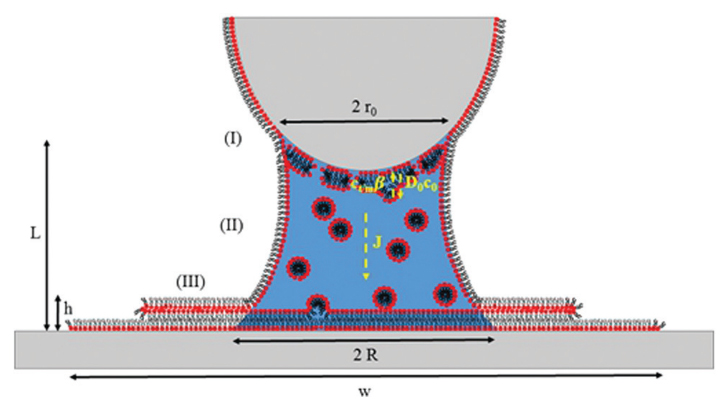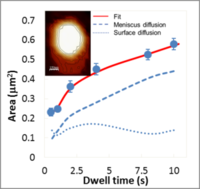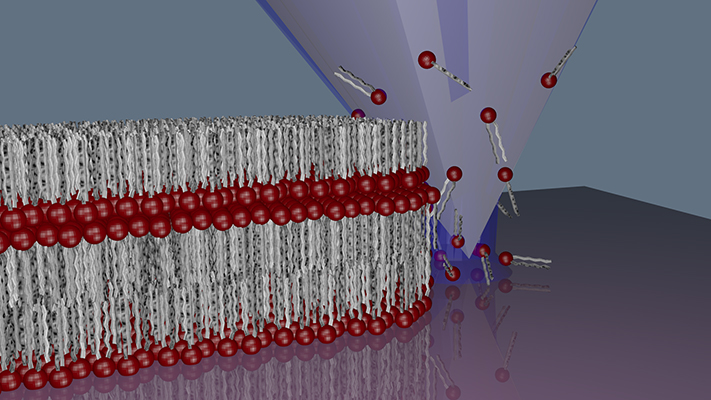Tailored biomimetic Membranes by SPL Methods
Lipid membranes have immense importance for life. They are ubiquitous in eukaryotic cells to compartmentalize volumes, enabling different milieus for biological tasks taking place in the specific organelles. The cell membrane itself, as the defining border to the environment, is made up by lipids as carrier for a plethora of proteins and other functional molecules, providing a myriad of functions in cell metabolism, communication and interaction with the outer world. Therefore, supported lipid membranes (SLBs) became an important research tool for screening studies, interaction studies and as interface to cells in research settings. While SPL methods already offer means to pattern a wide range of functional phospholipid mixtures, they are still struggling to pattern with arbitrary lipid mixtures, hindering applications requring certain components and mix ratios desired for natural cell membrane mimicking. In particular, the incorporation of membrane proteins is still an open challenge and would open up a tremendeous amount of applications in drug screening and sensing when combined with the posibillty for arraying and multiplexing that comes with the SPL methods (and are not accesible in alternative methods as SLBs by vesicle fusion). In this project we strive to further advance the SPL methods for generation of even more complex and nature-like biomimetic lipid membranes and show their potential for applications.
Selected Publications
Functional Lipid Assemblies by Dip-Pen Nanolithography and Polymer Pen Lithography
M. Hirtz, S. Sekula-Neuner, A. Urtizberea, H. Fuchs
in Soft Matter Nanotechnology: From Structure to Function, first edition. X. Chen, H. Fuchs (eds.) Wiley-VCH, Weinheim (2015) 161-177, DOI:10.1002/9783527682157.ch06
Biomimetic Phospholipid Membrane Organization on Graphene and Graphene Oxide Surfaces: a Molecular Dynamics Simulation Study
N. Willems, A. Urtizberea, A. F. Verre, M. Iliut, M. Lelimousin, M. Hirtz, A. Vijayaraghavan, M. S. P. Sansom
ACS Nano 11 (2017) 1613-1625, DOI:10.1021/acsnano.6b07352
Polymer Pen Lithography with Lipids for Large-Area Gradient Patterns
R. Kumar, A. Urtizberea, S. Ghosh, U. Bog, Q. Rainer, S. Lenhert, H. Fuchs, M. Hirtz
Langmuir 33 (2017) 8739-8748, DOI:10.1021/acs.langmuir.7b01368
In depth Characterization of bio-mimetic Lipid Membrane Structures generated by Dip-Pen Nanolithography
Dip-pen nanolithography with lipids (L-DPN) has become a great tool for patterning structured supported lipid membranes with a height range from a single lipid layer (~2 nm) up to layers of 200 nm thickness.

Lipids are delivered through the condensed water meniscus to become ‘physisorbed’ on the substrate, where they self-assemble into a lipid membrane. Humidity controls the phase behavior of the ink at the tip as well as the water meniscus itself; eventually it also controls the lipids diffusion within the assembled membrane and its spreading overthe substrate. Depending on the surface properties (hydrophilic or hydrophobic and substrate surface energy) the phospholipids self-assembles either into three dimensional stacks of membranes or are rather spreading to form a single, thin and homogeneous membrane. Generally, the time the tip is in contact with the substrate (dwell time) controls the amount of ink delivered.

We analyse quantitatively the influence of these experimental variables on the feature size, which gives an insight into the membrane growth process, thus allowing us to propose models that describe the processes from the writing to the self-organization of the lipids into membranes.
A robust and braodly applicable model of L-DPN will help to improve the quality of control over the prepared samples, by enabling a systematic informed choice of ideal materials and/or combination of materials for a given need.
![]()
![]() The research leading to these results has received funding from the People Programme (Marie Curie Actions) of the European Union's Seventh Framework Programme FP7/2007-2013/ under REA grant agreement n° 328163
The research leading to these results has received funding from the People Programme (Marie Curie Actions) of the European Union's Seventh Framework Programme FP7/2007-2013/ under REA grant agreement n° 328163
Selected Publications
A diffusive ink transport model for lipid dip-pen nanolithography
A. Urtizberea, M. Hirtz
Nanoscale 7 (2015) 15618-15634, DOI:10.1039/C5NR04352B
Functional Lipid Assemblies by Dip-Pen Nanolithography and Polymer Pen Lithography
M. Hirtz, S. Sekula-Neuner, A. Urtizberea, H. Fuchs
in Soft Matter Nanotechnology: From Structure to Function, first edition. X. Chen, H. Fuchs (eds.) Wiley-VCH, Weinheim (2015) 161-177, DOI:10.1002/9783527682157.ch06
Ink transport modelling in Dip-Pen Nanolithography and Polymer Pen Lithography
A. Urtizberea, M. Hirtz, H. Fuchs
Nanofabrication 2 (2016) 43-53, DOI:10.1515/nanofab-2015-0005
Biomimetic Phospholipid Membrane Organization on Graphene and Graphene Oxide Surfaces: a Molecular Dynamics Simulation Study
N. Willems, A. Urtizberea, A. F. Verre, M. Iliut, M. Lelimousin, M. Hirtz, A. Vijayaraghavan, M. S. P. Sansom
ACS Nano 11 (2017) 1613-1625, DOI:10.1021/acsnano.6b07352

